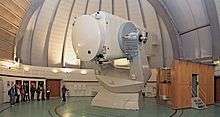100268 Rosenthal
| Discovery [1] | |
|---|---|
| Discovered by | F. Börngen |
| Discovery site | Karl Schwarzschild Obs. |
| Discovery date | 5 October 1994 |
| Designations | |
| MPC designation | (100268) Rosenthal |
Named after |
Hans Rosenthal [1] (German TV host) |
| 1994 TL16 · 2003 AG8 | |
|
main-belt [1][2] · (inner) background [3][4] | |
| Orbital characteristics [2] | |
| Epoch 23 March 2018 (JD 2458200.5) | |
| Uncertainty parameter 0 | |
| Observation arc | 27.33 yr (9,984 d) |
| Aphelion | 2.8514 AU |
| Perihelion | 2.0281 AU |
| 2.4398 AU | |
| Eccentricity | 0.1687 |
| 3.81 yr (1,392 d) | |
| 57.994° | |
| 0° 15m 30.96s / day | |
| Inclination | 11.756° |
| 22.570° | |
| 355.59° | |
| Physical characteristics | |
Mean diameter | 3±1 km (calculated)[5] |
| 15.6[2] | |
|
| |
100268 Rosenthal, provisional designation 1994 TL16, is a background asteroid from the inner region of the asteroid belt, approximately 3 kilometers (2 miles) in diameter. It was discovered on 5 October 1994, by German astronomer Freimut Börngen at the Karl Schwarzschild Observatory in Tautenburg, eastern Germany. The asteroid was later named for German radio and TV host Hans Rosenthal.[1]
Orbit and classification
Rosenthal is a non-family asteroid from the main belt's background population.[3][4] It orbits the Sun in the inner asteroid belt at a distance of 2.0–2.9 AU once every 3 years and 10 months (1,392 days; semi-major axis of 2.44 AU). Its orbit has an eccentricity of 0.17 and an inclination of 12° with respect to the ecliptic.[2] The body's observation arc begins with a precovery published by the Digitized Sky Survey. It was taken at the Siding Spring Observatory in September 1990, more than 4 years prior to its official discovery observation at Tautenburg.[1]
Physical characteristics

Diameter estimate
Based on its absolute magnitude of 15.6, its diameter is between 2 and 5 kilometers, assuming an albedo in the range of 0.05 to 0.25.[5]
Since asteroids in the inner main-belt are often of a brighter silicaceous – rather than of a darker carbonaceous composition, with higher albedos, typically around 0.20, the asteroid's diameter might be on the lower end of NASA's published conversion table, as the lower the reflectivity (albedo), the larger the body's diameter for a given absolute magnitude.[5]
As of 2018, Rosenthal's effective size, shape, pole, spectral type and composition, as well as its albedo and rotation period remain unknown.[2][6]
Naming
This minor planet was named in honour of German radio and TV host Hans Rosenthal (1925–1987), a German Jew who survived the Holocaust as a boy inside Germany and became one of the country's most popular TV show masters ever in the early 1980s. He died of cancer at the age of 61.[1] The approved naming citation was published by the Minor Planet Center on 13 April 2006 (M.P.C. 56615).[7]
References
- 1 2 3 4 5 6 "100268 Rosenthal (1994 TL16)". Minor Planet Center. Retrieved 6 June 2018.
- 1 2 3 4 5 "JPL Small-Body Database Browser: 100268 Rosenthal (1994 TL16)" (2018-01-22 last obs.). Jet Propulsion Laboratory. Retrieved 6 June 2018.
- 1 2 "Asteroid (100268) Rosenthal – Proper elements". AstDyS-2, Asteroids – Dynamic Site. Retrieved 6 June 2018.
- 1 2 "Asteroid 100268 Rosenthal". Small Bodies Data Ferret. Retrieved 6 June 2018.
- 1 2 3 "Asteroid Size Estimator". CNEOS NASA/JPL. Retrieved 6 June 2018.
- ↑ "LCDB Data for (100268) Rosenthal". Asteroid Lightcurve Database (LCDB). Retrieved 28 June 2017.
- ↑ "MPC/MPO/MPS Archive". Minor Planet Center. Retrieved 6 June 2018.
External links
- Asteroid Lightcurve Database (LCDB), query form (info)
- Dictionary of Minor Planet Names, Google books
- 100268 Rosenthal at AstDyS-2, Asteroids—Dynamic Site
- 100268 Rosenthal at the JPL Small-Body Database
